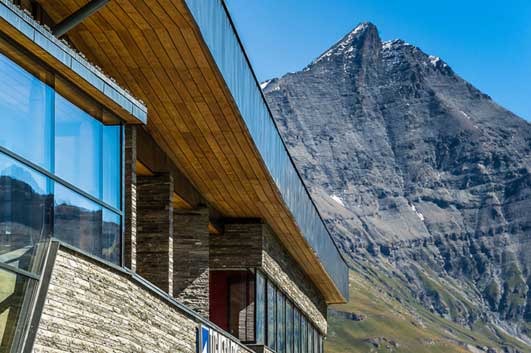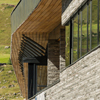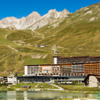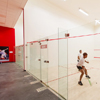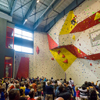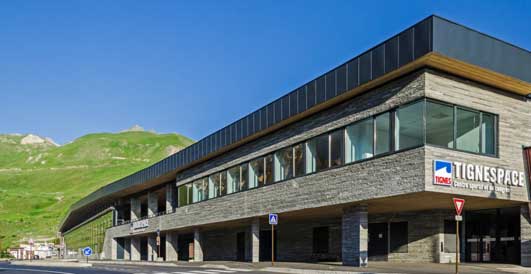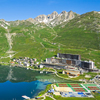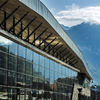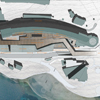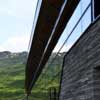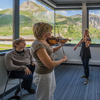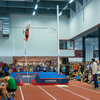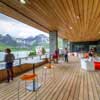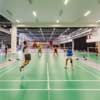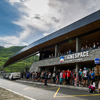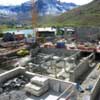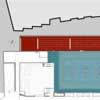Tignespace Building, Tarentaise Valley Development, Savoie Architecture
Tignespace, Tarentaise Valley
Savoie Building, Rhône-Alpes, France – design by Atelier Plexus architects / SG-Architecte
29 + 28 Oct 2013
Tignespace in Savoie
Design: Alain PALMA of Atelier Plexus architects & Sylvain GIACHINO of SG-Architecte
Location: Tignes, Tarentaise Valley, Savoie department, Rhône-Alpes region, south-eastern France
Tignespace, indoor sports centre and conference centre
An organic, changing, living creature
The new indoor sports and conference centre in Tignes is an extraordinary project that meets the ambitious challenge of providing an exceptional facility very discreetly, without fuss. Located in a restricted site, its single stone and glass façade mirrors the majestic mountain and lake landscape around Tignes. The building’s 8,300 m2 are buried under a planted roof, visible from all angles, which will become a flowery meadow in summer and a young children’s ski area in winter.
For some years, there has been a new factor in high-level sport: some athletes of all disciplines go to train in artificially depressurised sports centres, mainly located in the Emirates, in order to improve their performance. These facilities are far away, technically very complex, and costly to build and maintain. Their environmental impact is also very high, or even unreasonable, in complete discord with present concerns. Therefore it is appropriate to imagine an economic, ecological solution that is easy accessible for French and European athletes and which takes advantage of an exceptional high-altitude natural environment. Therefore the Tignespace concept was developed.
At the same time, the conference center become an additional advantage to grow the resort’s commercial and events activities.
This building, which is unique in Europe, is for high-level athletes, but is also available for use by the general public and for seminars and conferences. Performance and adaptability are the key words for this amenity, which has been designed and built sustainably. Its organic form and several technical constraints did not deter the design team from looking for simple construction solutions.
History of a project
The story of Tignes is similar to that of other high mountain towns. In 1952, the original village was submerged by the waters of the Chevril dam. Some years later, pioneers of snow sports settled on the edge of the natural lake, at an altitude of 2,100 m. In 1956, construction of the ski resort started, and the architect Raymond Pantz designed his first tourist accommodation. The “Paquebot des neiges” is a typical example: a building whose arc form follows that of the lake and provides a panoramic view of the mountain cirques. This “unité touristique” [meaning “tourist unit”, inspired by the name of Le Corbusier’s Unité d’habitation] is all-inclusive, with apartments on the upper floors, and a pedestrian shopping arcade that runs through the building on the ground floor. A gymnasium was built beside the bottom of this building in the 1980s with a simple design, consisting of concrete walls and a steel pan roof terrace.
Sylvain Giachino, a native of Tignes, devised the conversion of this gymnasium into a high-level sports complex as a design project for his architectural diploma. He worked with the local town hall, the various public services and Tignes Développement, the operator, to meet the expectations for the future Tignespace as well as possible. In parallel, Tignes was voted “The most sporting town” in 2008. The programme was then adapted to the dimensions of national competitions and of indoor activities that were previously never found at an altitude of 2,000 m, particularly with its athletics track and its climbing wall. The idea was to sustain life in the resort all year round, by diversifying activities and enhancing the image of an innovative sporting resort, capable of organising large events such as Tignes Airwaves, X Games Tignes and the New Year Fire Mix Party.
In 2009, the town hall organised a competition. The winners were Alain Palma of Atelier Plexus Architects and Sylvain Giachino. Atelier Plexus Architects, a Grenoble-based firm that led the project, has more than 30 years experience of building in mountain sites.
Merging into a restricted but outstanding site
Heaving ground
The new amenity replaces the old gymnasium, of which the structure will be partly retained. Built right up the large curved apartment block, it must keep a very low roofline in order to avoid interrupting the occupants’ view. In addition, its form is dictated by a narrow plot of land that is inserted between the apartment building and the road. The scheme’s form is the result of all these constraints: an elongated, partly underground building. it also determines the construction choices and the general organisation, giving priority to the athletes’ comfort in a project that is largely bathed in daylight. The large glazed panels of the south facade seem to lift up the roof, which is in the form of a crust of planted soil, like heaving ground or a deep crevasse.
Scored rock
The single façade determines the appearance of the entire project and echoes the majestic landscape. By its colour and its texture of scored rock, the Vals stone recalls Les Tufs mountain, which faces the building. The large glazed area is a second mirror of the natural setting, as a reference to the lake.
The stone, a very hard quartzite, is worked by breaking it in a way that preserves its rough finished appearance and highlights the tangle of green and blue, grey and white veins. It catches the light and calls to mind a reduced-scale cliff. Three heights of stone were chosen and assembled at random, horizontally, to increase the effect of striations and the façade’s horizontality. Small recessed joints create shadows and stress the thickness of the solid stones. A very specific effort was made together with the construction contractors in order to learn more about this exceptional product, including a visit to the quarry, tests of various samples and training of stonemasons.
The large panels of glazing allow daylight into the entire depth of the building. In winter, the south / south-west façade will benefit from the reflection of light on the mountains. This lighting from one single direction does not create glare for players, especially as the games areas are positioned parallel to the façade. Adding to the mirror effect, this play of transparency creates a showcase effect when, after nightfall, the indoor activities become visible from the street.
The façade consists of a double wall, 2.50 m wide, protected by a slight overhang. It provides good thermal insulation, houses all services installations in order to free the roof of any clutter, and contains solar protection between the two skins of the façade in order to re-balance light or to exclude it completely during a show. Sunscreen blinds soften the light, which can also be moderated by artificial lighting.
The façade is made up two glass curtain walls. The external skin of wall, consisting of structural sealant glazing, is hung on slender timber posts, while the internal skin is supported by the drop elements of the metal structure.
Transparency, adaptability and flexibility
The main challenge was to harmoniously combine an indoor sports centre and a conference centre, without mixing the circulation flows, while keeping the various functions clearly visible, with great transparency between the different spaces.
The sports part occupies the west wing, and the conference centre occupies the east. The two meet at the reception area, which is the core of the scheme from the viewpoints of design and function. Above this is the lounge area, which opens onto a very spacious external terrace, looking onto the mountain.
The transparency between the spaces contributes to creating a lively place, with continuous views from the eastern end to the climbing wall. It bathes the entire building in high-quality natural light, which is a remarkable achievement for a building that is largely underground.
Programme
Made up of three floor levels, including one underground, the programme is exceptional:
– a 1,600 m2 multi-sports area that can house 6 team sports or individual sports in ten different configurations
– a 900m2 athletics area with five sprint tracks and areas for pole-vaulting area, high jump, long jump and triple jump
– an adjacent 115 m2 body-building room
– a national standard climbing approved by the FFME
– 3 squash courts and 2 multi-sports halls with removable partitions
– a 384-seater auditorium
– 13 flexible meeting rooms with floor areas of between 14 and 188 m2
– a lounge area with enough space planned to provide light meals for 400 people.
To complete this project, the design team enlisted the expertise of various specialists for the structure, acoustics and scenographic design, as well as high-level sportsmen such as Jean Galfione (the scheme’s patron) for athletics, Christophe Billon (of the FFME French Mountaineering and Climbing Federation) for climbing, and Laurent Chambertin, manager of Tignespace and former volleyball champion.
As well as being gigantic, the amenity has the qualities of a chameleon. It is an adaptable, flexible, changing building. The spaces are designed to be transformed and adapted for different uses during the day and/or according to the season or requirements. All possible scenarios were examined from the outset. In addition to being multi-purpose, it is made up of adaptable, flexible spaces, which completely changes the building’s atmosphere and interior.
For example, the multi-sports area is very large and adaptable, and it can accommodate several sports activities at the same time. Various different layouts of the spaces can be partitioned by curtains that are hung on clamps fixed to the revealed structure. The multi-sports area opens easily onto the athletics area, and its glazed internal partitions allow visitors to watch the sports.
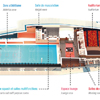
photograph © Tignes Developpement
This 1,600 m2 sports area is also used as a 1,500-seater hall for shows. The glazed external walls are then totally blacked out, the structure acts as a technical grid to support the sound and lighting installations, and the floor is covered with wood and linoleum flooring. A technical service access is provided directly from the underground car park, and the sports equipment store-room can be used as the technical control room for shows. All the sound and lighting installations required for shows have been incorporated to allow this transformation.
Similarly, as the scheme progressed, the 384-seater auditorium was designed so that, in the long-term, it could be used as a cinema and a high-level conference centre. On the ground floor, a technical and services part is on one continuous level with the stage, which has a cinema screen. The tiered seating, whose elliptical cross-section and semi-circular form are designed according to cinema standards, with 1.15 m unobstructed passage and comfortable armchairs fitted with writing flaps. All equipment is housed in the walls, including sound and lighting installations, which can include a 3D cinema projector. The acoustics are of high quality, with sound-absorbing walls, ceilings and floors. A public exit is provided onto the lounge space in the conference configuration, and directly onto the exterior for the cinema configuration.
A technically complex project
From the construction viewpoint, since the scheme was inserted into a narrow plot with considerable height restriction, it was decided to choose a metal structure, which is unusual for a high-mountain building. A steel post and beam structure allows long spans without intermediate bearing points and with slender elements that can carry the extra weight of snow. A concrete substructure is provided for the basements, car parks and foundations. It includes the existing car parks and the gymnasium walls, which are retained and inserted into the new building. A nailed surface ensures the ground’s stability for bearing the sports centre against the apartment building. The roof consists of composite steel / concrete pans of the Cofradal type, which are covered by planted grasses. The roof vegetation is exactly the same as that covering the surrounding Alpine meadows, thereby enabling it to be visually integrated into the landscape as well as possible in the summer.
The building was completed without any delay despite the constraints of the unpredictable high mountain climate, practically without running over the budget.
Inside, the widespread use of wood for facings, linings and the structure contrasts with the external stone. Timber and wood, the typical construction materials in mountain areas, are used here in a contemporary style. The wood creates a “warm heart” as opposed to the stone that alludes to the mountain spirit.
A harmonious colour scheme of reds and oranges is applied throughout the building (for paintwork, ceramic tiling and furniture) and plays with the neutral tones of the façade. All detailing of finishes was designed and drawn in advance, which required a considerable amount of design time.
An integral urban development complex
Tignespace is not an isolated architectural object that is cut off from its environment. It plays an urban role by its programme and its form, and it reorganises pedestrian circulation flows and passage routes. It strives to place the “tourist unit” again at the core of a coherent whole. For the side facing the lake was always neglected in favour of a north entrance towards the ski slopes, leading to the decline of the shopping arcade on the ground floor. The architects aim to reinstate the entrances in all their forms, and they intend to create a ski slope on the roof, linking the slope and the central square, and thereby reversing people’s behaviour and developing an image.
Tignespace is a very high performance facility, designed and built within a perspective of open-ended flexibility, which is considered the best option for an environmental approach. Public buildings must be the result of long-term thinking, particularly in high-mountain areas and in winter sports resorts where nature and landscape play a major role. Tignespace is a giant that has all the intrinsic capacities for adaptation and transformation.
Alain Palma, Atelier Plexus architects
Alain Palma has been joint managing partner of Atelier Plexus Architects in Grenoble since July 2009. As well as designing private buildings, he has specific expertise in the design of public amenities for sport and entertainment.
A graduate of the Ecole Nationale Supérieure d’Architecture in Grenoble, this mountain enthusiast pays special attention to the environmental aspects and the technical mastery of projects. The firm’s activity is developing mainly in the Isère and Savoie areas of France.
Sylvain Giachino
Sylvain Giachino founded the SG-Architecte firm in 2007 in Paris, then in 2010 in Lyon. A native of Tignes, he provides all of his projects with his good knowledge of the specific environmental aspects of high-altitude resorts and the “mountain spirit”. Within a contemporary dynamic, he requires buildings to be exemplary in terms of architectural quality and of sustainable development. He is attentive to the unique features of the setting and of the site, while developing a singular new approach to space, light, materials and landscape.
Tignespace Rhône-Alpes – Building Information
Design: Alain PALMA of Atelier Plexus architects & Sylvain GIACHINO of SG-Architecte
Location: Tignes is a commune in the Tarentaise Valley, Savoie department in the Rhône-Alpes region in south-eastern France
Client: Commune de Tignes
Project Owner’s representative: SAS Société d’Aménagement de la Savoie
Main architects: Atelier Plexus architectes – Alain Palma
Associated architect: SG-Architecte – Sylvain Giachino et Simon Boudet
Tignespace, Tarentaise Valley, Rhône-Alpes images / information from Alain PALMA of Atelier Plexus architects & Sylvain GIACHINO of SG-Architecte
Location:Tignes, Savoie, Rhône-Alpes, France
New Buildings in France
French Architectural Projects
French Architecture Design – chronological list
French Architect Offices – design firm listings
Paris Architecture Tours by e-architect
Another southern French building on e-architect:
Refuge du Goûter, Saint Gervais Les Bains, southeast France
Design: Déca-Laage + Groupe-H
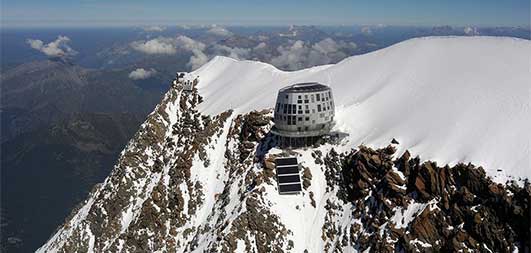
photograph : Gudrun Bergdahl
French Alps Building
Lycée René Goscinny, Alpes-Maritimes, southeast France
Design: José Morales architecte, Marseille
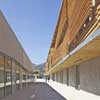
photograph : Philippe Ruault
Lycée René Goscinny France
French Buildings
Lycée René Goscinny, Alpes-Maritimes, southeast France
Design: José Morales architecte
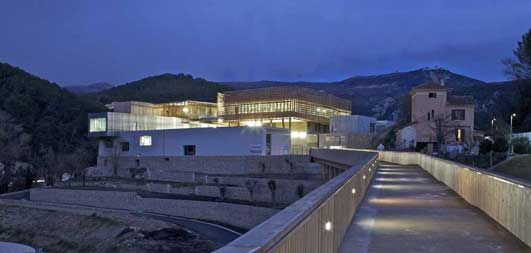
photo : Philippe Ruault
Lycée René Goscinny France
Comments / photos for the Tignespace Building – Tarentaise Valley Architecture page welcome
Tignespace Savoie Building : page

